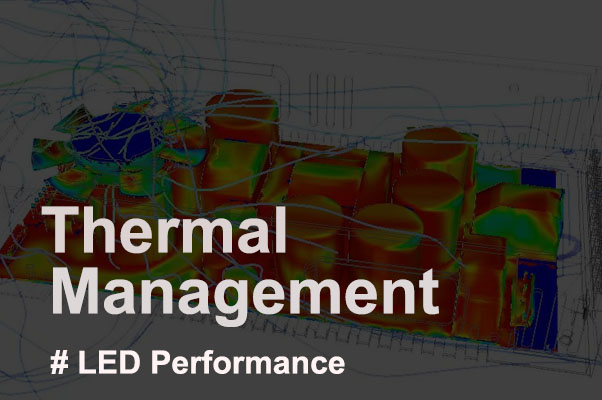LED light sources have been widely adopted globally due to their high efficiency, long lifespan, energy savings, environmental friendliness, and durability. Despite these advantages, LEDs have certain drawbacks, such as releasing significant amounts of heat during operation, which can affect their efficiency and lifespan. LED light manufacturing companies have made various improvements to the thermal design of LEDs, such as using materials with better thermal conductivity, improving heat sink fins, and applying special surface treatments to heat sinks. These improvements have significantly enhanced the overall performance of LEDs. Besides these design improvements to the lamps themselves, the thermal management of LED drivers (power supply modules), which are critical components of LED lights, is also crucial. This article will focus on the implementation of thermal management in LED drivers and how it can further enhance the overall performance of LED lights.
Part One: Causes of Heat Generation in LED Drivers and Its Impact on LED Lights
Causes of Heat Generation
During operation, LED drivers generate heat due to the energy conversion processes in electronic components. The main sources of heat include:
- Power Semiconductor Devices: Components like MOSFETs and IGBTs generate heat due to losses during switching. For instance, in high-power LED drivers, MOSFETs can generate several watts (W) of heat due to their on-resistance.
- Transformers and Inductors: Magnetic cores generate heat losses due to hysteresis and eddy current effects. The combined copper and iron losses in high-frequency transformers can account for 5%-10% of total power.
- Rectification and Filtering Circuits: Diodes’ forward voltage drop and the Equivalent Series Resistance (ESR) of filter capacitors generate heat. Each ampere (A) of current flowing through a diode can generate about 0.7 watts (W) of heat, and the ESR of filter capacitors can generate several watts.
Impact on LED Lights
The heat generated by LED drivers affects both their stability and lifespan and the overall LED system in the following ways:
- Reduced Luminous Efficiency: High temperatures lower the photoelectric conversion efficiency of LED chips, decreasing their luminous efficiency. For example, every 10°C rise in LED chip temperature can reduce luminous efficiency by approximately 2-4%.
- Shortened Lifespan: The lifespan of LEDs is closely related to their operating temperature. Higher temperatures accelerate LED light decay, reducing their lifespan. Typically, every 10°C increase in LED chip temperature halves its lifespan.
- Thermal Failure: In high-temperature environments, electronic components in LED drivers are prone to thermal failure, causing lamp malfunctions. Statistics show that for every 10°C increase in temperature, the failure rate of semiconductor devices doubles.
Part Two: Design and Implementation of Thermal Management in LED Drivers
Principles of Thermal Management Design
- Efficient Heat Dissipation: Optimize heat dissipation paths to quickly remove internal heat.
- Reducing Heat Generation: Use high-efficiency, low-loss components to reduce overall heat dissipation.
- Temperature Monitoring: Incorporate temperature sensors to continuously monitor the operating temperature of LED drivers and prevent overheating.
Implementation Methods
- Using Thermally Conductive Materials: In designing LED drivers, use materials with excellent thermal conductivity, such as thermal silicone and thermal pads, to enhance heat dissipation. For example, the thermal conductivity of thermal silicone can exceed 1.0 W/m·K.
- Optimizing PCB Layout: Arrange components logically to avoid clustering high-heat components together. Optimize the thickness and area of the PCB’s copper foil to enhance thermal performance. Increasing copper thickness to 2 oz can enhance heat dissipation by 1-2 W per square inch.
- Incorporating Heat Sinks: In high-power LED drivers, add heat sinks, such as aluminum fins, to increase the heat dissipation area and improve heat dissipation efficiency. Aluminum heat sinks have a thermal conductivity of about 200 W/m·K, effectively reducing temperature.
- Active Cooling Designs: For high-power, high-heat LED drivers, use active cooling designs like fans or liquid cooling to further enhance heat dissipation. Introducing fans can lower temperatures by 10-15°C.
- Smart Temperature Control Systems: Implement temperature control chips and sensors to monitor the temperature of LED drivers in real-time. Adjust operational states as needed, such as reducing output power or activating active cooling devices, ensuring the temperature remains within a safe range. A smart temperature control system can set overheat protection triggers at 85°C to ensure system stability.
Case Study
An LED lighting company incorporated high-efficiency thermal design into its new products, using thermally conductive materials and optimized heat dissipation structures, reducing the LED driver’s temperature by 15°C. Specific data include:
- Thermal materials reduced the temperature by 5°C.
- PCB optimization and thicker copper reduced the temperature by 3°C.
- Adding aluminum heat sinks reduced the temperature by 5°C.
- The smart temperature control system further reduced the temperature by 2°C.
The company also adopted a smart temperature control system, ensuring stable luminous efficiency and lifespan even after prolonged use. These thermal management improvements not only enhanced the product’s overall performance but also strengthened its market competitiveness.
Optimizing the thermal management design of LED drivers can effectively reduce their operating temperature, improve their stability and lifespan, and indirectly enhance the luminous efficiency and reliability of the entire LED light system. As technology continues to advance, thermal management design for LED drivers will become more refined and intelligent, providing a solid foundation for the further development of LED lighting.
